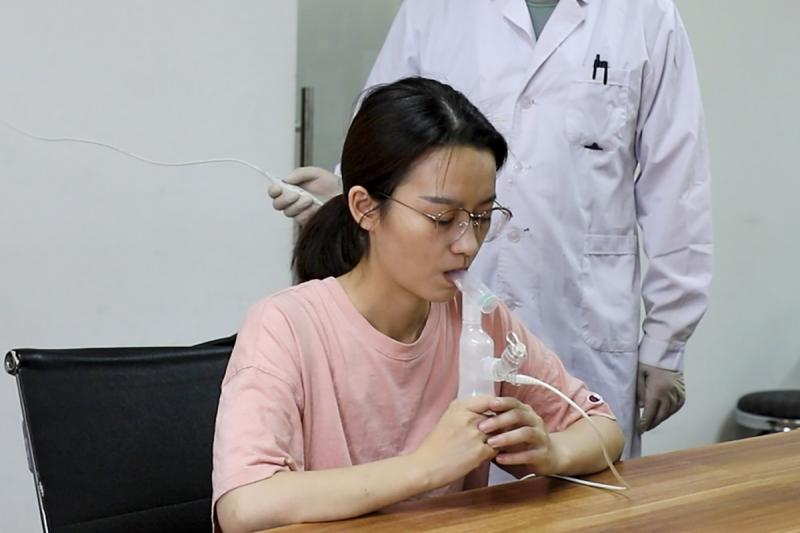Every Covid-19 vaccine that has been cleared for use so far is meant to be injected into the upper arm, but scientists are exploring a different method of delivery - through the nose and mouth.
Of the more than 100 Covid-19 vaccines undergoing clinical studies recognised by the World Health Organization, eight are intranasal vaccines.
These are designed to target the mucosa of the nose and throat area where the coronavirus first enters the body, and offer a different immune response.
Last week, China's CanSino Biologics published the results of an early-stage clinical trial which found that an aerosol inhaled version of its Ad5-nCoV vaccine - which is already approved for use in a single-dose, injectable form in China, Pakistan and Mexico - triggered immune responses without serious side effects.
Two inhaled doses of the vaccine given 28 days apart, each a fifth of the injectable dose in volume, induced similar levels of neutralising antibodies to those of a single injection of the same vaccine, according to the peer-reviewed paper by researchers from the Beijing Institute of Biotechnology, the Academy of Military Medical Sciences and CanSino.
Some of the 130 Chinese trial participants received a single dose of the injectable version of the vaccine followed by an inhaling booster 28 days later. The group induced strong neutralising antibody responses, according to the paper.
"In conclusion, the aerosol inhalation of Ad5-nCoV is painless, simple, well tolerated, and immunogenic," researchers wrote in the paper published in medical journal The Lancet Infectious Diseases on Monday.
With the researchers saying the data supports phase 2 and 3 clinical trials for the inhaled vaccine, they may be one step closer to becoming a reality. Here's what you need to know about them.
How do inhaled vaccines work?
Injected vaccines induce systemic immune responses that do not specifically target the pathogen's region of infection. Inhaled vaccines, meanwhile, specifically target mucosal surfaces - the nose, throat and lungs, the point of entry for pathogens - to induce a localised immune response.
In an interview broadcast on the military channel of state broadcaster China Central Television (CCTV) on Wednesday, researchers showed how the CanSino vaccine would be administered through a special inhaler.
Such responses produce slightly different antibodies from the ones produced from the blood, known as immunoglobulin A, and are important in protecting the respiratory tract from infection.
Studies in the 1960s and 1970s showed that the inhalation of influenza and measles vaccines gave some protection.
What are the benefits compared with injected vaccines?
Injected vaccines usually require cold storage and trained health personnel, presenting a problem in non-industrialised countries and remote areas.
Inhaled vaccines, on the other hand, can be administered through disposable devices without the need for trained personnel, making mass vaccinations easier.
It could also appeal to those who are afraid of needles. In the CCTV broadcast, Hou Lihua, a researcher from the Academy of Military Medical Sciences working on CanSino's inhaled vaccine, said it could "greatly increase" people's willingness to be vaccinated.
She said the inhaled vaccine required much lower doses than the injected one, which would make it easier to produce more.
Professors Yuen Kwok-yung and Chen Honglin, from the University of Hong Kong, have developed an inhaled vaccine that is in the early stage of clinical trials.
They said injected vaccines would induce a systemic immune response but it was not clear how far that extended into the respiratory tract, according to a HKU statement in March.
Nasal spray vaccines are designed more specifically to induce immunity in the airways and animal experiments show they can also induce systemic immunity. They are also expected to produce a low number of allergic reactions.
How about the challenges?
One paper, by Wouter Hinrichs, from the University of Groningen, published in Expert Review of Vaccines in March suggested that inhaled vaccines, especially when stored in a dry powder form, could be kept for much longer in a stable form than liquid vaccines meant to be injected.
But questions about their durability have yet to be conclusively resolved. While the CanSino study found no serious side effects among the phase 1 participants, it also could not rule out the possibility of such side effects.
Hinrichs' study also found that while the immune response observed in mucosal surfaces was likely to play a key role in defending the respiratory tract from pathogenic invasions, it could also damage the lungs or worsen the effects of the disease if the response was too strong.
Who else is developing inhaled vaccines?
Inhaled vaccines are relatively new and mostly used for influenza, but CanSino is not the only one looking at developing one to tackle Covid-19.
The spray by Yuen and Chen from HKU is designed to offer protection against influenza and Covid-19 and is being developed with the support of the Coalition for Epidemic Preparedness Innovations.
Oxford University is also studying the immune responses from the nasal administration of the Covid-19 vaccine it developed with AstraZeneca, with a 30-volunteer initial trial.
Another trial to test the safety and immune response of COVI-VAC, a single-dose, intranasal vaccine from the US firm Codagenix, is being tested in Britain.
Similar vaccines are also being tested in Australia and India.
However, one proposed nasal spray vaccine, from the US company Altimmune, has been scrapped after it failed to induce a satisfactory immune response.

